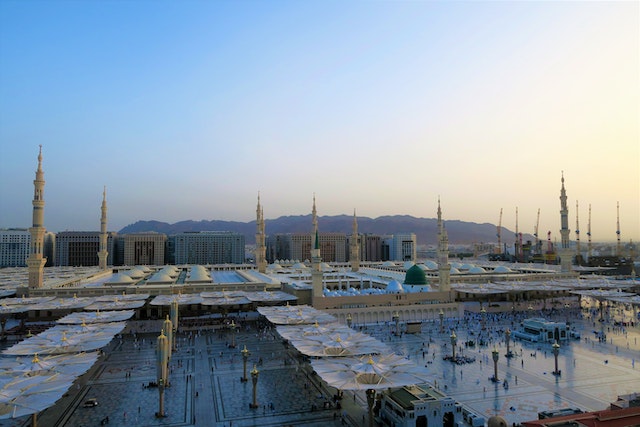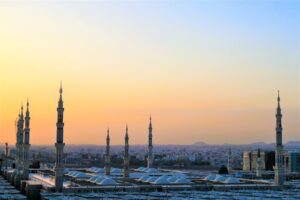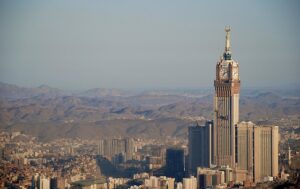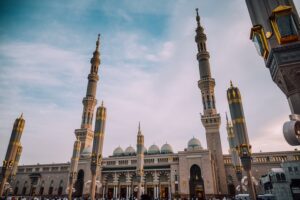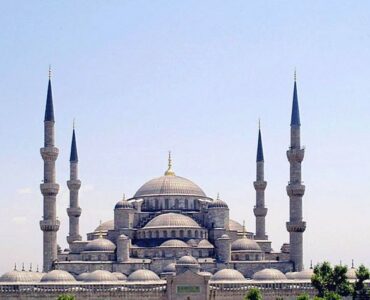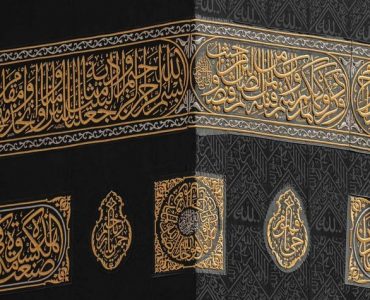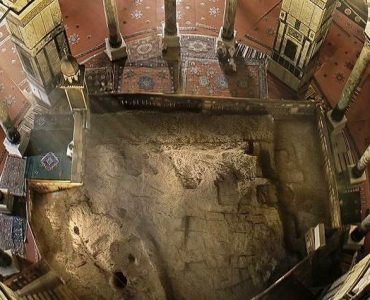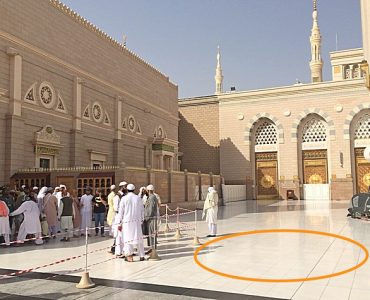In a world graced with countless wonders and historical treasures, Madinah, or Medina, stands as a beacon of spiritual significance and historical splendor.
Situated in the western region of Saudi Arabia, this city holds a profound place in the hearts of millions.
It boasts not only serene landscapes but also a rich tapestry of history and culture, making it a destination unlike any other.
Whether you’re a devout Muslim embarking on a pilgrimage or a curious traveler eager to immerse yourself in the Islamic heritage, the Madinah promises a unique and enriching experience.
Throughout this guide, we will highlight the top places to visit in Madinah that should be on your itinerary.
Read on to learn why Madinah is known as the city of peace and why it warmly welcomes travelers from around the world.
What Is Madinah?
Located in the Madinah province in Saudi Arabia, Madinah is renowned for being the second holiest city in Islam after Mecca, and it plays a central role in the life and history of the Islamic faith.
The city of Madinah holds a special place in the hearts of Muslims around the world because it was the destination of the Prophet Muhammad (peace be upon him) during the Hijrah, or migration, in the year 622 CE.
This event marks the beginning of the Islamic calendar and signifies the establishment of the first Islamic community in Madinah.
Madinah is often referred to as “The City of the Prophet” (PBUH) and is a significant pilgrimage site for Muslims.
It is home to some of the most sacred sites in Islam, including the Prophet’s Mosque (SAW) (Al-Masjid an-Nabawi) and the Quba Mosque.
Is It Worth Visiting Madinah?
Visiting Madinah is a deeply personal choice, influenced by your interests and motivations for travel. However, for many, it holds immense value.
Madinah’s religious significance as the second holiest city in Islam, housing the final resting place of the Prophet Muhammad (PBUH), is undeniable.
Pilgrims visit Madinah as part of their religious journey, paying respects to the Prophet (SAW) and seeking spiritual fulfillment.
Beyond religious importance, Madinah’s historical and cultural heritage, warm hospitality, educational opportunities, and memorable experiences make it a worthwhile destination.
Is It Better To Go to Mecca or Medina First?
The sequence of visiting Mecca and Medina hinges on the nature of the pilgrimage, be it Hajj or Umrah, and individual preferences.
For Hajj, there’s a prescribed order beginning in Mecca, followed by Medina, while Umrah allows more flexibility, with many opting for Mecca first.
Both cities bear immense spiritual significance, often leading pilgrims to commence in Mecca, the heart of Islam, before proceeding to Medina to honour the Prophet (PBUH).
Practical factors while visiting Saudi Arabia, such as travel logistics and plans play a role, with advanced planning and consultation with halal travel organisers recommended to ensure a well-organised pilgrimage aligned with one’s religious intentions.
Top Religious Places in Al-Madina Al-Munawwarah
In the following section, we will explore some of the most significant places in Al-Madinah al-Munawwarah. Whether you seek historical insights or a profound spiritual journey, these sacred places to visit in Madinah are sure to leave a lasting impression.
What Is the Most Important Place In Madinah?
Madinah shimmers with spiritual significance and historical importance, and at its heart lies a place of unparalleled importance in the Islamic world – Masjid Al Nabawi.
Let’s delve into the heart of Madinah and explore Masjid Al Nabawi and other important places in Madinah in detail.
1.) Masjid Al Nabawi: The Most Important Place in Madinah
Also known as the Prophet Mosque, Masjid Al Nabawi stands as a testament to the deep-rooted spirituality of Madinah. It is the second holiest mosque in Islam, after the Masjid al-Haram in Mecca.
The mosque’s history is intertwined with the life of the Prophet Muhammad (PBUH) and the birth of the Islamic faith. Its serene interior is adorned with exquisite calligraphy and intricate designs, creating an atmosphere of reverence and awe.
Its striking dome, often illuminated at night, is an iconic symbol of Madinah.
One of the most revered aspects of Masjid Al Nabawi is the Rawdah, a green area within the mosque believed to be part of the Garden of Paradise.
It is here that the Prophet Muhammad (peace be upon him) is buried. Pilgrims and visitors from around the world come to offer prayers and pay their respects at this sacred site.
2.) Quba Mosque: The Oasis of Faith
Nestled on the outskirts of Madinah, the Quba Mosque, also known as Masjid Quba’, stands as an oasis of faith and a beacon of tranquility in the Arabian desert.
Quba Mosque holds the honour of being the first mosque founded by the Prophet Muhammad (peace be upon him) upon his arrival in Madinah during the Hijrah (migration) in 622 CE.
Masjid Quba’s architecture reflects the simplicity and humility advocated by Islam. Its structure is characterised by whitewashed walls, soaring minarets, and a stunning dome.
The serene courtyard is shaded by date palm trees, offering a peaceful retreat for worshippers and visitors.
Visiting the Quba Mosque carries immense spiritual rewards. It is reported in several Hadiths that performing ablution (wudu) at one’s home and then offering two Rak’ah of prayer at Quba Mosque is rewarded with the equivalent of an Umrah pilgrimage.
Make sure you add this mosque to your list when you visit Medina.
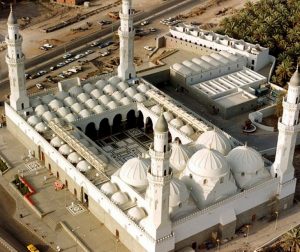

Is Medina the Cleanest City in the World?
Medina has received recognition from the World Health Organisation (WHO) as one of the world’s healthiest cities.
This accreditation underscores the city’s commitment to meeting global health standards and providing a clean and healthy environment for its residents and visitors.
3.) Qiblatain Mosque: The Mosque of the Two Qiblas
The Qiblatain Mosque, or Masjid Qiblatain, is another place of religious significance located in the vibrant city of Madinah.
The Qiblatain Mosque is renowned for its role in a significant event in Islamic history.
During the early days of Islam in Madinah, Muslims used to pray facing Jerusalem (known as the First Qibla).
However, Allah (SWT) revealed a new direction of prayer, or Qibla, towards the Kaaba in Mecca (known as the Second Qibla).
The Qiblatain Mosque’s architecture is a harmonious blend of modern and traditional elements. Its gleaming white façade and distinctive dome are a sight to behold.
The mosque’s interior is adorned with intricate calligraphy and calming hues, creating an atmosphere of reverence and devotion.
Worshippers come to Qiblatayn Masjid to offer prayers and reflect upon the importance of unwavering faith in the face of change and challenge.
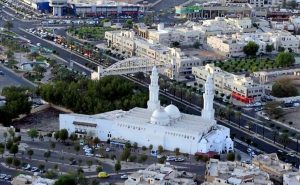

How Long Should You Spend In Medina?
The ideal duration for a stay in Medina depends on your purpose and interests. Pilgrims on Umrah or Hajj can fulfill essential rituals and visit the Prophet’s Mosque (SAW) in 2 to 3 days.
Those seeking a deeper spiritual experience or historical exploration may opt for 3 to 5 days or more, allowing for visits to various sites and personal reflection.
Travelers interested in culture and sightseeing can spend time immersing themselves for several days.
Plan your stay duration and time to match your goals and make the most of your time in this holy city.
4.) Masjid Abu Bakr: A Tribute to a Pious Companion
Named after Abu Bakr, the first Caliph and the closest companion of Prophet Muhammad (PBUH), this mosque is one of the most notable sites Madinah has to offer.
It serves as a tribute to a towering figure in Islamic history.
Masjid Abu Bakr is a testament to the profound relationship between Abu Bakr and the Prophet Muhammad (peace be upon him).
Abu Bakr was not only a trusted friend and companion but also the father-in-law of the Prophet (SAW), as his daughter Aisha (رضي الله عنها) was married to Muhammad (peace be upon him).
He was the first adult male to embrace Islam and played a pivotal role in supporting and propagating the faith during its early years.
The mosque’s architectural design is a modest place of worship, with whitewashed walls, a peaceful courtyard, and a small prayer area.
The mosque’s unassuming appearance serves as a reminder of the simple and humble nature of Abu Bakr (رضي الله عنه).
Worshippers often engage in supplication and recitation of the Quran within the mosque’s serene environs, drawing inspiration from the life of a man renowned for his unwavering faith and dedication.
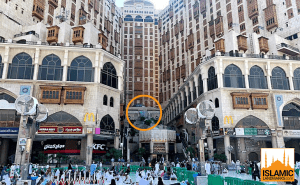

5.) Jannat al-Baqi: The Garden of Heaven on Earth
Jannat al-Baqi is one of the most renowned historical places in Saudi Arabia. Often referred to simply as “Baqi Cemetery” or “Baqi al-Gharqad,” this historic cemetery is located in the holy city of Madinah, Saudi Arabia.
Its name, Jannat al-Baqi, translates to “Garden of Heaven” or “Paradise of Baqi.”
Jannat al-Baqi is renowned for being the burial site of numerous companions of the Prophet Muhammad (peace be upon him), including members of his family, early scholars, and prominent figures from the early days of Islam. Among those buried here are:
- Fatimah bint Muhammad: The daughter of the Prophet Muhammad (peace be upon him) and wife of Ali ibn Abi Talib (رضي الله عنهم).
- Hasan ibn Ali: The elder grandson of the Prophet Muhammad (peace be upon him).
- Uthman ibn Affan: The third Caliph of Islam.
- Abu Huraira: A renowned companion known for his narrations of Hadith (sayings and actions of the Prophet SAW).
- Aisha bint Abi Bakr: The wife of the Prophet Muhammad (peace be upon him) and a prominent scholar of Islam.
The cemetery features rows of unadorned graves, each marked by a simple headstone. The serene atmosphere and the shade of date palm trees create a peaceful and reflective environment, allowing visitors to pay their respects and engage in prayer and remembrance.
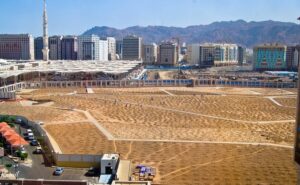

Historical Islamic Places/Landmarks in Madinah
Madinah is a treasure trove of historical Islamic landmarks that bear witness to the early days of Islam and the life of the Prophet Muhammad (peace be upon him).
Let’s explore the rich heritage and spiritual significance of these sacred sites. Make sure you plan your visit with enough time to explore the following.
6.) Uhud Mountain: A Testament to Faith and Sacrifice
Uhud Mountain, located just north of Madinah, Saudi Arabia, is a place of immense historical and spiritual significance in Islam.
It gained prominence due to its association with the Battle of Uhud, a crucial event in Islamic history that took place in 625 CE.
During this battle, the faith and determination of the Prophet Muhammad (peace be upon him) and his companions were tested as they faced a formidable Quraysh army from Mecca.
Today, Uhud Mountain is home to the graves of many martyrs, including Hamza ibn Abdul-Muttalib, the Prophet’s (SAW) beloved uncle.
These graves serve as a poignant reminder of the sacrifices made by early Muslims.
The mountain also offers a place for spiritual reflection, drawing pilgrims and visitors who seek to contemplate the lessons of faith, resilience, and unity that the Battle of Uhud teaches.
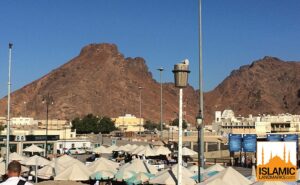

Is Medina Walkable?
Medina is generally a walkable city, especially in and around the central areas where most of the important Islamic landmarks and religious sites are located.
The city has pedestrian-friendly zones and sidewalks that make it convenient for visitors to explore on foot.
In fact, many pilgrims and tourists prefer walking within the vicinity of the Prophet’s Mosque (SAW) (Masjid Al Nabawi) and other significant locations to soak in the spiritual atmosphere and take their time to pray and reflect.
However, there are several attractions in Madinah. Medina is a relatively large city, and the distances between some places from your hotels can be substantial.
Depending on your specific itinerary and the sites you plan to visit, you may find that using local transportation options, such as buses or taxis, can be more efficient for reaching certain destinations, especially those on the outskirts of the city.
7.) Wadi e Jinn: The Valley of Illusions and Legends
Wadi e Jinn, often referred to as the “Valley of the Jinn,” is a unique natural wonder located in the Al-Namas governorate of Saudi Arabia, approximately 30 kilometers from Abha.
What sets this valley apart is the captivating and seemingly perplexing phenomenon experienced by visitors – vehicles appear to move uphill without any apparent external force.
Local folklore suggests that jinn, supernatural beings in Islamic tradition, inhabit the valley, giving rise to tales of mystical encounters.
While the phenomenon may spark intrigue and curiosity, its explanation lies in the laws of physics and the peculiar geography of the valley.
Despite the scientific explanation, Wadi e Jinn remains a popular tourist destination, drawing visitors from Saudi Arabia and around the world.
People come to witness the illusion, capture the mysterious ambiance, and perhaps ponder the enduring allure of legends and the enigmatic nature of the natural world.
Best Sightseeing Places in Madinah
Madinah has many places to visit.
It offers a wealth of sightseeing opportunities, tourist places, hotels, and restaurants that allow visitors to immerse themselves in its unique blend of tradition and modernity.
Here are some of the best sightseeing places Madinah has to offer.
8.) The Beautiful Names of Allah Exhibition: A Spiritual Journey
The Beautiful Names of Allah Exhibition is an immersive exhibition dedicated to showcasing and celebrating the 99 beautiful names and attributes of Allah as described in Islamic tradition.
It offers a unique opportunity for visitors to deepen their understanding of the divine while exploring the artistry and culture of the region.
At this exhibition, visitors are introduced to the profound meanings behind each of the 99 names of Allah.
Through interactive displays, audiovisual presentations, and artistic depictions, guests embark on a spiritual journey to connect with the divine attributes of Allah, such as the Most Merciful, the All-Knowing, and the Ever-Forgiving.
It provides a space for reflection and meditation, allowing individuals to contemplate the boundless nature of the divine.
9.) Dar Al Madinah Museum: Unveiling the City’s Rich Heritage
Dar Al Madinah Museum, located in the heart of Madinah, serves as a gateway to the past. The museum’s primary mission is to preserve and showcase the historical, cultural, and architectural aspects of Madinah.
It features an impressive collection of artifacts, manuscripts, and exhibits that tell the story of this city’s transformation over the centuries.
Visitors can explore artifacts related to the life of the Prophet Muhammad (peace be upon him), his companions, and the early Islamic community.
It provides insights into the city’s role in the early days of Islam and the contributions of its residents.
Dar Al Madinah Museum offers an interactive learning experience. Visitors can engage with multimedia displays, visual aids, and informative exhibits that make history come alive.
It’s an educational destination for people of all ages, providing a deeper understanding of Madinah’s significance.
10.) Assalam Museum: A Gateway to Islamic Heritage
Assalam Museum is dedicated to preserving and promoting all things related to Islamic heritage. Its extensive collection includes manuscripts, historical artifacts, and works of art that reflect the diverse and profound aspects of Islamic civilisation.
Visitors to Assalam Museum embark on an educational exploration of Islam’s history and the contributions of Muslim scholars, scientists, and artists.
Multimedia displays, interactive exhibits, and informative presentations make the learning experience engaging and enlightening.
The museum actively engages with the local community and international visitors. It hosts cultural events, lectures, and exhibitions that foster intercultural dialogue and promote a deeper understanding of Islam’s values and principles.
11.) Hejaz Railway Museum: Tracing the Tracks of History
The Hejaz Railway Museum, nestled in the heart of Madinah, Saudi Arabia, is a good place to visit during your stay in Madinah. It stands as a tribute to the historical significance of the Hejaz Railway and its impact on the region’s development.
This museum offers visitors a fascinating journey back in time to explore the history, engineering marvels, and cultural implications of this iconic railway.
The Hejaz Railway was a monumental project of the early 20th century aimed at connecting Istanbul, Turkey, with Madinah, Saudi Arabia, and beyond.
It played a crucial role in shaping the Arabian Peninsula’s history and transforming the way people and goods were transported through the region.
The museum promotes cultural exchange and dialogue by providing a space for people from diverse backgrounds to connect with the history and heritage of the Hejaz Railway.
It serves as a bridge between different cultures and a platform for understanding the shared history of the Arabian Peninsula.
Is Madinah Open to Non-Muslims?
Madinah is generally open to non-Muslims, with certain restrictions in place, such as limited access to the interior of the Prophet’s Mosque (SAW) (Masjid Al Nabawi). However Mecca is not open to non-muslims.
Non-Muslim visitors are expected to dress modestly, adhere to respectful behavior and conduct, and be mindful of Islamic practices and customs.
It’s important for non-Muslim travelers to be aware of local regulations and guidelines and to show respect for the religious and cultural norms of Madinah during their visit.
Places to Visit in Makkah
Many visitors choose to include Makkah in their travel itinerary either before or after their stay in Madinah, as both cities hold immense significance in Islamic history.
In Makkah, several important sites await exploration.
At the heart of it all is the Kaaba, the holiest site in Islam, a cube-shaped structure nestled within the vast Masjid al-Haram, one of the world’s largest mosques.
Pilgrims follow the footsteps of Hagar by walking between the Hills of Safa and Marwah, a key religious ritual.
The Black Stone, a sacred cornerstone of the Kaaba, holds deep significance and is touched or kissed by pilgrims during their circumambulation.
The Abraj Al-Bait Towers, including the iconic Clock Tower, provide luxurious accommodations and breathtaking views of the city.
Lastly, Mina and Muzdalifah serve as vital pilgrimage sites during the Hajj, where rituals are performed and stones are gathered.
These destinations collectively form an essential part of the spiritual journey for Muslims and offer a profound cultural and historical experience for all visitors.
While exploring Saudi Arabia, if you have the time, consider extending your journey to nearby destinations such as Jeddah. Jeddah is a coastal city blending tradition and modernity.
Jeddah is also known for its bustling souks, offering an array of goods from spices to jewelry. You will get a chance to sample authentic Saudi cuisine in Jeddah.
You can also consider visiting Riyadh, the bustling capital offering a glimpse into Saudi Arabia’s history and culture.
For a change of scenery, a short flight to Dubai in the United Arab Emirates presents a vibrant, cosmopolitan atmosphere with iconic landmarks, shopping, dining, and desert adventures.
These neighboring cities provide diverse experiences to complement your Saudi Arabian exploration.
Summary – Places to Visit in Madinah
Madinah, the radiant city of Saudi Arabia, offers a blend of spiritual and cultural attractions.
The Prophet’s Mosque (SAW) (Masjid Al Nabawi) is a centerpiece where the Prophet Muhammad (SAW) is buried, drawing Muslims from around the world. Other significant sites include:
- Quba Mosque:The first mosque built in Islam, a serene and spiritually significant site.
- Qiblatain Mosque:Known for the historical event where the direction of Muslim prayer (Qibla) was changed.
- Uhud Mountain:Site of the Battle of Uhud, a significant historical event in early Islamic history.
- Jannat al-Baqi:A historic cemetery where many companions of the Prophet Muhammad (SAW) are buried.
- Dar Al Madinah Museum:An institution preserving and showcasing the cultural and historical heritage of Madinah.
- Assalam Museum:A museum that explores Islamic heritage, art, and history.
These are just a few of the notable attractions to explore in Madinah, each offering a unique glimpse into the city’s rich religious and cultural heritage.
Plan your visit to explore these sacred and cultural landmarks firsthand.
Book you tour and discover the rich history and spirituality of Madinah today!

